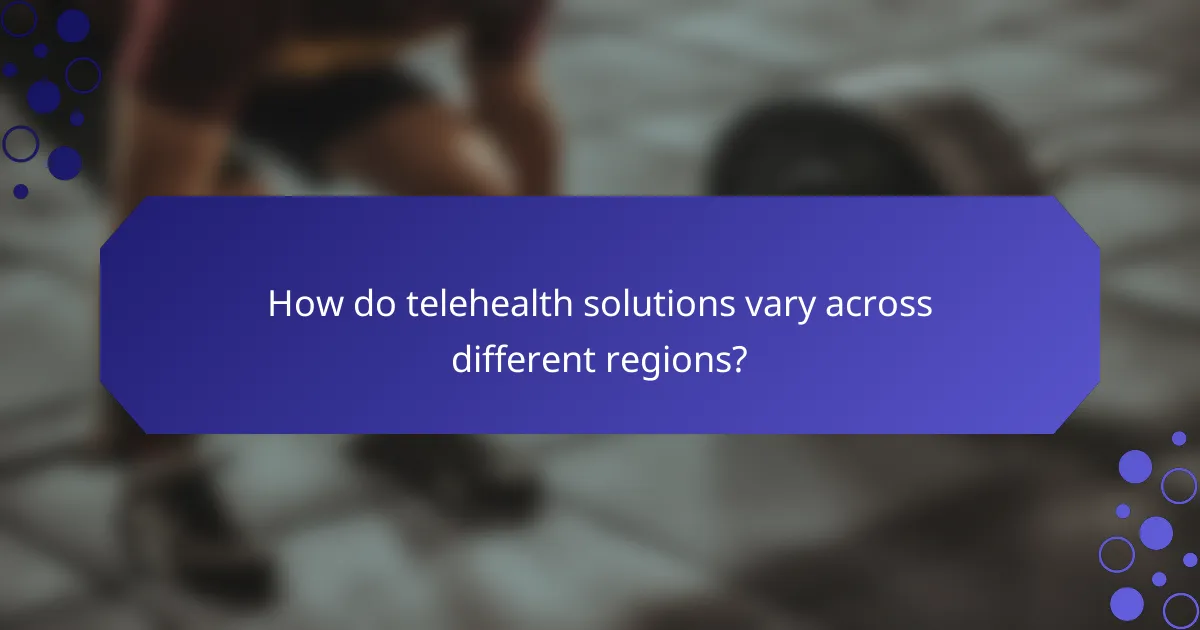Telehealth solutions significantly enhance chronic condition management by providing accessible care and improving patient engagement. This article explores the benefits of telehealth, including reduced healthcare costs and enhanced monitoring. It also addresses challenges such as technology integration and regulatory compliance. Finally, it examines effective telehealth models and future trends shaping chronic condition care.

What are the key benefits of telehealth solutions for chronic condition management?
Telehealth solutions enhance chronic condition management by providing accessible, continuous care. Key benefits include improved patient engagement, reduced healthcare costs, and enhanced monitoring capabilities. Patients can receive timely interventions, minimising complications. Telehealth also facilitates better communication between patients and providers, leading to personalised care plans. Additionally, remote access to specialists expands treatment options.
How does telehealth improve patient access to care?
Telehealth significantly enhances patient access to care by removing geographical barriers and enabling remote consultations. Patients can connect with healthcare providers from their homes, improving convenience and reducing wait times. Telehealth also supports chronic condition management through regular monitoring and timely interventions, leading to better health outcomes. As a result, individuals in underserved areas gain access to specialised care that may otherwise be unavailable.
What cost savings can be achieved through telehealth?
Telehealth can achieve significant cost savings by reducing travel expenses, minimising hospital readmissions, and lowering overall healthcare costs. For example, virtual consultations eliminate transportation needs, saving patients time and money. Additionally, studies show that telehealth can reduce hospital readmission rates by up to 30%, which further decreases healthcare expenditures. The potential for remote monitoring of chronic conditions can lead to early intervention, ultimately saving costs associated with advanced disease management.
How does telehealth enhance patient engagement and adherence?
Telehealth enhances patient engagement and adherence by providing accessible, real-time communication with healthcare providers. This immediate interaction fosters a supportive environment, encouraging patients to actively participate in their care.
Telehealth solutions, such as video consultations and mobile health apps, allow for personalised feedback and education. This tailored approach increases patients’ understanding of their chronic conditions and treatment plans, leading to improved adherence.
Moreover, telehealth facilitates regular monitoring and follow-ups, which can significantly reduce the likelihood of missed appointments. Studies indicate that patients who engage through telehealth are more likely to stick to their treatment regimens, resulting in better health outcomes.
The future of telehealth includes advancements in technology, such as AI-driven analytics, which will further enhance engagement by offering predictive insights into patient behaviour and needs. This evolution promises to make chronic condition management more effective and patient-centred.
What role does technology play in telehealth effectiveness?
Technology enhances telehealth effectiveness by improving access, communication, and data management. It enables remote monitoring, allowing healthcare providers to track chronic conditions in real-time. This leads to timely interventions and personalised care plans. Additionally, telehealth platforms facilitate seamless communication between patients and providers, fostering better engagement. Data analytics tools help identify trends and outcomes, optimising treatment strategies. As a result, technology significantly contributes to better health outcomes and patient satisfaction in chronic condition management.

What challenges do healthcare providers face when implementing telehealth solutions?
Healthcare providers face several challenges when implementing telehealth solutions. Key issues include technology integration, patient engagement, regulatory compliance, and reimbursement complexities.
Technology integration often requires significant investment in infrastructure and training. Many providers struggle with ensuring that various systems communicate effectively. Patient engagement is critical; providers must encourage patients to utilise telehealth services, which can be difficult for those unfamiliar with technology.
Regulatory compliance presents challenges due to varying state laws and guidelines. Providers must navigate these complexities to ensure they meet legal requirements. Additionally, reimbursement complexities arise as telehealth services may not be covered by all insurance plans, impacting the financial viability of these solutions.
Addressing these challenges is essential for the successful adoption of telehealth in chronic condition management.
How do regulatory barriers impact telehealth adoption?
Regulatory barriers significantly hinder telehealth adoption by imposing strict compliance requirements. These regulations can limit provider participation and restrict reimbursement policies. As a result, patients may face challenges accessing necessary telehealth services. The complexity of navigating state and federal laws adds to the difficulties for healthcare providers.
What are the common technological limitations of telehealth platforms?
Telehealth platforms face several common technological limitations. These include inconsistent internet connectivity, which can disrupt service delivery. Security concerns also arise, as sensitive patient data may be vulnerable to breaches. Additionally, user interface issues can hinder accessibility, particularly for older adults. Limited integration with existing healthcare systems can create data silos, affecting continuity of care. Finally, the variability in technology adoption among patients and providers can lead to disparities in access and usage.
How does patient resistance affect telehealth uptake?
Patient resistance significantly hinders telehealth uptake by creating barriers to engagement and adherence. Factors influencing this resistance include concerns about technology usability, lack of personal interaction, and skepticism about the effectiveness of virtual care. For instance, studies indicate that patients with chronic conditions may prefer in-person visits, fearing that telehealth lacks the same quality of care. Addressing these concerns through education and support can enhance acceptance and utilisation. Engaging patients in the decision-making process and offering user-friendly technology can also mitigate resistance and improve telehealth adoption.

Which telehealth models are most effective for chronic condition management?
Telehealth models that are most effective for chronic condition management include remote patient monitoring, teleconsultations, and integrated care platforms. Remote patient monitoring provides continuous data, enhancing patient engagement and timely interventions. Teleconsultations improve access to specialists, reducing travel and wait times. Integrated care platforms facilitate coordinated care among providers, ensuring holistic patient management. Each model addresses unique challenges and offers distinct benefits, shaping the future of chronic condition care.
What are the differences between synchronous and asynchronous telehealth services?
Synchronous telehealth services provide real-time interactions, while asynchronous telehealth services allow for communication at different times. Synchronous methods include video calls or live chats, enabling immediate feedback. Asynchronous options, such as email or recorded messages, offer flexibility for both patients and providers. Each method has unique benefits; synchronous services enhance engagement, while asynchronous services improve accessibility. Understanding these differences is crucial for effective chronic condition management.
How do integrated telehealth services compare to standalone solutions?
Integrated telehealth services offer a comprehensive approach to chronic condition management compared to standalone solutions. Integrated services provide seamless care coordination, enhancing patient engagement and outcomes. Standalone solutions may lack the holistic support necessary for managing complex health needs.
Integrated telehealth utilises data sharing across platforms, enabling real-time adjustments to treatment plans. This integration fosters a collaborative environment among healthcare providers, which is crucial for chronic conditions requiring continuous monitoring. Standalone solutions often operate in silos, limiting communication and potentially leading to fragmented care.
The future of telehealth indicates a trend toward more integrated systems, as patients increasingly seek cohesive and efficient management of their health. Research shows that integrated approaches can lead to a 30% improvement in patient adherence to treatment plans. Therefore, while standalone solutions have their merits, integrated telehealth services are positioned to deliver superior outcomes for chronic condition management.

How do telehealth solutions vary across different regions?
Telehealth solutions vary significantly across regions due to differences in technology infrastructure, regulatory environments, and healthcare access. In urban areas, advanced telehealth platforms often integrate AI and remote monitoring, enhancing chronic condition management. Conversely, rural regions may rely on basic telephonic consultations due to limited internet access.
For example, the United States has robust telehealth regulations and widespread insurance coverage, allowing for diverse service offerings. In contrast, some developing countries face regulatory hurdles and lack of funding, limiting telehealth’s effectiveness. Future trends indicate a potential increase in global telehealth adoption, driven by technological advancements and changing patient needs.
What are the unique telehealth practices in North America?
Unique telehealth practices in North America focus on personalised care, remote monitoring, and integrated technology. These practices enhance chronic condition management by providing tailored solutions that address individual patient needs. For example, platforms utilise artificial intelligence to analyse health data and predict potential complications. Additionally, many telehealth services offer virtual support groups, fostering community and shared experiences among patients. As a result, these innovative approaches improve patient engagement and adherence to treatment plans.
How do cultural factors influence telehealth acceptance in various populations?
Cultural factors significantly influence telehealth acceptance among various populations. These factors include beliefs about health, trust in technology, and accessibility to digital resources.
For example, communities with strong traditional health practices may resist telehealth solutions due to skepticism about technology. In contrast, populations with higher technological literacy are more likely to embrace telehealth for chronic condition management.
Additionally, socioeconomic status impacts access to telehealth services. Populations with lower income may lack the necessary devices or internet connectivity, hindering acceptance.
Cultural attitudes toward healthcare providers also play a role. Trust in healthcare professionals can lead to higher telehealth utilisation, while distrust may limit engagement. Understanding these cultural dynamics is essential for tailoring telehealth solutions effectively.

What future trends are shaping telehealth for chronic condition management?
Telehealth is increasingly shaped by advancements in technology, patient-centred care, and regulatory changes. Key trends include the integration of artificial intelligence for personalised treatment plans, the expansion of remote monitoring devices, and the growing emphasis on mental health support. These trends enhance accessibility, improve patient engagement, and facilitate timely interventions. As telehealth evolves, it addresses challenges like data security and reimbursement policies, ensuring comprehensive chronic condition management.
How is artificial intelligence transforming telehealth services?
Artificial intelligence is significantly enhancing telehealth services by improving patient monitoring, diagnosis accuracy, and personalised treatment plans. AI algorithms analyse vast amounts of health data, enabling timely interventions for chronic conditions. For instance, predictive analytics can identify potential health deteriorations before they occur, allowing for proactive care. Additionally, AI-driven chatbots provide immediate support, reducing the workload on healthcare professionals. As a result, telehealth becomes more efficient and accessible, ultimately improving patient outcomes and satisfaction.
What advancements in wearable technology are influencing telehealth?
Wearable technology significantly influences telehealth by enhancing remote monitoring and patient engagement. Devices like smartwatches and fitness trackers collect real-time health data, enabling proactive management of chronic conditions. These advancements improve communication between patients and healthcare providers, leading to timely interventions. Integration of AI in wearables offers personalised insights, which can further optimise treatment plans.
How might policy changes affect the future of telehealth?
Policy changes can significantly enhance telehealth by improving access and reimbursement. Increased insurance coverage for telehealth services encourages providers to adopt these solutions. Regulatory adjustments can streamline licensing, allowing practitioners to serve patients across state lines. Enhanced data privacy laws may also bolster patient trust in telehealth. As a result, telehealth may evolve into a standard practice for chronic condition management, addressing existing challenges and expanding its reach.
What best practices should healthcare providers follow when implementing telehealth solutions?
Healthcare providers should prioritise user-friendly technology, ensure robust data security, and maintain clear communication channels when implementing telehealth solutions. These best practices enhance patient engagement and trust. Additionally, providers must offer training to staff and patients to optimise the use of telehealth platforms. Regularly evaluating the effectiveness of these solutions can identify areas for improvement and address challenges.
